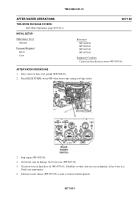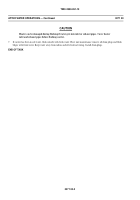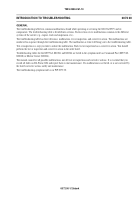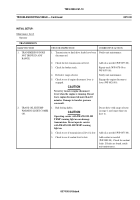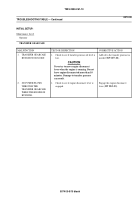TM-9-2350-261-10 - Page 418 of 761
TM 9-2350-261-10
TROUBLESHOOTING TABLE — Continued
0074 00
MALFUNCTION
TEST OR INSPECTION
CORRECTIVE ACTION
4.
ENGINE CRANKS TOO
SLOW TO START.
1.
Check to see if battery cable connections are
clean and tight, and battery water is up to
correct level (WP 0085 00).
Use outside power source
(WP 0027 00) or tow start
(WP 0065 00) the carrier. If the
cause of slow cranking is not
obvious, have unit maintenance
troubleshoot the electrical system.
2.
If temp erature is colder th an
-
25 F (32 C)
check to see if engine disconnect lever is
engaged (WP 0026 00).
CAUTION
Never try to move the engine disconnect
lever when the engine is running. Do
not leave engine disconnected more than
10 minutes. Damage to the transfer
gearcase can result.
Disengage the engine disconnect
lever (WP 0026 00).
If engine still cranks too slowly,
record fault on DA Form 2404
and notify unit maintenance.
5.
ENGINE LABORS, RUNS
ROUGH, STALLS, OR
DOES NOT PUT OUT
FULL POWER.
1.
Check to see if engine is getting enough air.
Check air cleaner restriction
indicator (WP 0004 00). If
indicator shows only red in the
window, notify unit maintenance.
2.
Check to see if there is water in the fuel.
Drain primary and secondary fuel
filters (WP 0090 00).
3.
High elevation operation.
The carrier will normally lose
power at high elevations
(mountain passes or high
plateaus). If carrier runs rough or
has a power loss, push air control
valve in (WP 0028 00) to draw
cooler air from rear compartment
and increase horsepower.
If carrier runs rough or without
much power, notify unit
maintenance.
6.
ENGINE OVERHEATS.
1.
Check to see if all power plant access panels
are in place and mounting clamps are tight.
CAUTION
Driving carrier with an overheated
engine can damage engine. When
ENGINE COOLANT TEMPERATURE
GAUGE indicates above 230 F(110 C),
stop carrier and run engine at 1000–1200
RPM until coolant temperature drops
below 230 F(110 C).
Install panels (WP 0048 00 and
WP 0049 00).
007400-2
º
º
º
º
º
º
Back to Top


